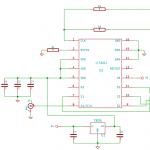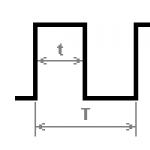More than a dozen years have passed since the appearance of the first mobile phone. Over time, they were constantly improved, new functions were added, and their sizes were reduced. But at one point, all the functions invented by engineers became cramped in the concept of “mobile phone”. This is how the concept of “communicator” arose, and then “smartphone”.
- Mobile phone(eng. mobile phone) – a portable communication device intended primarily for voice communication.
- Smartphone(English smartphone - smart phone) - a mobile phone, supplemented with the functionality of a pocket personal computer.
- Communicator(English communicator, PDA phone) – a pocket personal computer, supplemented with the functionality of a mobile phone.
The presence of a fully functional operating system makes smartphones and communicators more attractive in the eyes of most users. Modern solutions (mid-price models and above) cope well with many tasks that go beyond telephone calls: working with email, viewing text documents and spreadsheets, working with a task scheduler and many others. Expanding the functionality of phones is possible through J2ME programs, which are supported by almost all mobile devices. The screen of a number of phones is as good as most smartphones, and many models are equipped with a memory card slot.
It is important to note that programs written specifically for the operating system of a smartphone or communicator are complete sequences of low-level microprocessor commands compiled into binary code. Specialized applications use processor resources more efficiently and, as a rule, have greater functionality than “general-purpose” J2ME programs.
However, for most users this circumstance is not the main selection criterion. Smartphones are promoted by manufacturers due to other factors, such as:
- Advanced multimedia features (better camera, enhanced video playback capabilities, improved music capabilities);
- Increasing the number of cores and processor frequency;
- Using a unique model design;
- Protecting the device from external influences.
The history of smartphones
What is the first smartphone? They tried to combine the functionality of a mobile phone and a communicator almost immediately after the appearance of the first communicators in the early 90s of the last century.
IBM Simon.
The cost of the device was about $900 with a contract and about $1100 without it. In addition to telephone functions, the device received organizer functions, was able to send and receive faxes, allowed you to work with e-mail, and also contained several games. There were no control keys, and all actions were performed via the touch screen. Due to its rather large dimensions and weight (0.5 kg), Simon did not receive significant distribution.
Characteristics and equipment:
- Touch display: 4.7" with a resolution of 293x160 pixels;
- RAM: 1 MB;
- Built-in memory: 1 MB;
- Operating system: Datalight ROM-DOS;
- Stylus included;
- Wireless charging;
- Two PCMCIA ports;
- Set for connecting to a computer;
- Set for RJ-11 connector;
- Ability to send and receive faxes;
- Possibility of connecting memory cards of 1 and 1.8 MB;
- Calendar, calculator, e-mail, notepad; world time, graphic editor, schedule, etc.
 Samsung Galaxy Nexus, Apple iPhone 4, wild tribes communication tool (bump) and IBM Simon (from left to right).
Samsung Galaxy Nexus, Apple iPhone 4, wild tribes communication tool (bump) and IBM Simon (from left to right).
Hewlett-Packard, together with Nokia, at the very beginning of 1996, released the 700LX communicator - an improved version of the HP 200LX with the ability to connect a Nokia 2110 mobile phone. The software was updated to synchronize work with a cell phone. But this device cannot be considered a communicator as such, since it consisted of two parts, independent of each other.
 HP OmniGo 700LX.
HP OmniGo 700LX.
Less than a year has passed since Nokia released the Nokia 9000 Communicator, a device that could combine a communicator and a mobile phone into one. This device received:
- QWERTY keyboard;
- GEOS operating system (without the ability to install applications);
- The black and white screen is quite high resolution for those times;
- Dimensions 173 x 65 x 38 mm, weight about 400 g.
Not without its drawbacks:
- Inability to install software;
- Lack of expandable functionality.
Over time, the 9xxx series PDA line was replaced by the 9000i, 9110 and 9110i.
 Nokia 9000 Communicator.
Nokia 9000 Communicator.
The following year, a company called High Tech Computer Corporation (HTC Corporation) was formed, the goal of which was to develop mobile devices that could combine the functionality of a telephone and a communicator.
In 1998, the Symbian consortium was founded to develop software for mobile devices. It included companies such as Psion, Motorola, Nokia and Ericsson.



 Symbian OS.
Symbian OS.
Meanwhile, Nokia felt quite confident in the communicator market. In 1999, models called Qualcomm pdQ 800 and pdQ 1900 were released for the US market. However, they were not particularly popular due to their large size, weight and price. 
 Qualcomm pdQ 800 (left) and pdQ 1900 (right).
Qualcomm pdQ 800 (left) and pdQ 1900 (right).
In 2000, a new Ericsson phone called R380s was released. It was what the manufacturer called a smartphone. Features of the R380s included:
- Relatively light weight and dimensions;
- Availability of a touch screen;
- Hinged lid.
Despite the name "smartphone", it could not be called such, if only because it did not allow the installation of third-party applications.
 Ericsson R380s.
Ericsson R380s.
Nokia released the Nokia 9210 communicator with a color screen in 2001. At this time, the active development of smartphones began. The new model ran Symbian OS 6.0 and it was the first device with an open OS. It was quite functional.
The same Nokia released the Nokia 7650, which is considered the first smartphone, as it ran on Symbian OS 6.1 (open to other developers). The manufacturer itself positioned its model not as an intelligent device with an open operating system, but as an image product with advanced multimedia functions. But its popularity was affected by significant drawbacks: small memory size and lack of a slot for memory cards.
In 2000, the first solutions were released that received Pocket PC 2000.
 Nokia 9210.
Nokia 9210.
 Nokia 7650.
Nokia 7650.
 Pocket PC 2000.
Pocket PC 2000.
Modern mobile phones and smartphones provide voice communication over a cellular network, receive and transmit text messages, and perform a number of other design-designed functions: notifications of calls and messages, alarm clock, calendar with notes, simple games, MMS, FM radio, Internet browser . It has become difficult for citizens to understand the difference between a smartphone and a telephone. Meanwhile, these devices, consonant in name and similar in function, are completely different. The main criteria by which it is customary to distinguish these mobile devices are as follows:
- presence/absence of an operating system;
- the ability to install applications yourself;
- design features of the hardware;
- Internet opportunities.
Control of smartphone functions is based on special software called an operating system (hereinafter referred to as OS). This fact allows us to consider a smartphone like a laptop computer. A smart mobile device can work with various applications, allow you to create and edit documents and images, as well as communicate with people via email and social networks. The above functionality is not available to the simple Java firmware of a cell phone. Therefore, for dummies, an important criterion for choosing a mobile device is the presence/absence of an operating system in the device description.
Important! The absence of an OS name in the characteristics of a mobile communication device is a fundamental difference between a phone and a smartphone.
There are several operating software options for smartphones, and the most popular of them are this is IOS, Android, Windows Phone. Depending on the OS used on board the smartphone, smart devices are divided into iPhones, Windows phones, Android smartphones and devices running other less common OS (BlackBerry OS, Tizen).

Windows Phone Operating System

Android operating system

Operating system IOS
The capabilities of smart gadgets thanks to operating software
The presence of an operating system significantly expands the functionality of a mobile device, and this is the main difference between a “smart” device and a cell phone. A mobile OS, like the operating “brain” of a computer, supports the operation of various programs: Internet browsers, instant messengers, programs for reading, listening to music, viewing photos and videos, various text and graphic editors, and application applications.
As a rule, manufacturers provide smartphones with a number of proprietary applications that provide the following functions:
- Internet access to search for any necessary information;
- playing audio and video recordings;

- creating playlists;
- correspondence by email;
- communication on social networks;
- photo and video shooting;

- creating notes, memos, contact books;
- creating and editing texts, graphs, tables, presentations and other office information;
- GPS navigation, working with maps, fitness capabilities;
- search and installation of third-party applications (app store);

- programs for reading books in electronic format;
- games and other entertainment;
- payment functions.
Important! The set of standard functions of a smartphone depends on the level of equipment of the hardware platform and the version of the operating system.
In addition to the programs provided by the manufacturer, the owner of a smartphone can install and use applications from third-party developers necessary to solve certain problems, search and It is recommended to install them through the application store.
The difference between a phone and a smartphone is hardware
The firmware of a regular phone ensures the interconnection of the device's components. This is a cellular communication module, display, keypad, speaker, microphone, battery, and other additional modules.


A smartphone, unlike a mobile phone, is much more complex. Like a computer, it built on a central processor, which, together with RAM and a graphics controller, forms the productive basis that generates commands for built-in modules. In addition to the basic architecture, including the chipset, RAM and ROM, the main modules of modern smartphones are:
- touch display;
- cellular communication module with 2G/3G/LTE modem;
- internal and external speakers and microphones, voice recorder;
- Wi-Fi, Bluetooth adapters;
- GPS navigation module and a set of sensors;
- main and front cameras;
- battery.

Depending on the status of the model and manufacturer, mobile smart devices can be equipped with the following functional elements:
- photo flash;
- NFC - chip;
- FM - radio receiver;
- fingerprint sensor;
- iris scanner.
The task of the operating system is management of potential smartphone functions, the provision of which is entrusted to the command-generating computing unit and built-in modules. Control is carried out using 2-3 physical buttons (power/lock, volume control, for example), touch buttons, a virtual keyboard and voice commands.
Access to the World Wide Web
Mobile operators provide users with a variety of tariff plans, most of them provide Internet traffic packages in networks of different generations (EDGE, 2G, 3G or 4G). All smartphones and most models of regular cell phones are equipped with support for networks of one level or another.

Advice! You can determine whether a device supports access to the World Wide Web by the presence of an installed browser.
After purchasing a SIM card with an optimal tariff, the user will not be required to make any special device settings upon first launch. Providers provide semi-automatic installation of cellular network parameters with minimal subscriber participation.
What is better to choose
What is better to choose, a telephone or a smartphone with Internet access? Much depends on the owner himself, his preferences and skills in using mobile devices. Both devices have their advantages and disadvantages.
Smartphones are multifunctional and productive, can replace a whole range of devices: from a voice communication device or a Wi-Fi source to an audio and video player, a camera or a payment device (terminal). And this is the undoubted advantage of smart devices.
Vulnerability to malware and viruses, the energy consumption of smartphones on the one hand, as well as the ability of users to master a wide range of functionality and considerable monthly tariff payments, on the other hand, make one think about the advisability of purchasing a smart device.
Advice! For older people and younger schoolchildren, a simple mobile phone is quite suitable, without unnecessary functionality that you still need to know how to use.
12.05.2013
In one of the articles we looked at the question of how to connect the Internet to a computer via a mobile phone.
When answering the question “ What is the difference between a smartphone and a telephone? ", most people mention the presence of a processor, while others consider the touch screen to be the main thing. What is the truth?
In order to give the most accurate answer about the differences between a smartphone and a telephone, one should turn to the history of the development of mobile technology, namely the early 90s of the last century, when mobile phones and personal digital assistants (PDAs) appeared on the market en masse. The functionality of mobile phones initially consisted only of making phone calls and sending SMS, and PDAs became indispensable assistants for business people as electronic organizers. Later, mobile phones acquired similar capabilities, and pocket PCs followed the path of unification with their desktop counterparts, the first mobile operating systems appeared and the productivity of the devices themselves increased. The unification of these two classes was only a matter of time...

Technologies are advancing by leaps and bounds. The powerful impulse of technological progress at the beginning of the twentieth century did not subside completely.
At the beginning of this century, a technological breakthrough gave birth to the entire field of information technology. Over time, they became closely intertwined with everyday life.
No modern person can do without computing technology. And so much so that he constantly carries a small pocket computer with him.
This is it smartphone , evolutionary successor to the first brick-shaped tubes and three-room tube computers.
What is a smartphone? A smartphone is, in the current sense of the word, “smart” cell phones.
There are several key differences from simple phones: the presence of a developed operating system that allows the installation of third-party applications (open OS) and greater computing power.
The difference between a smartphone and a telephone
Despite the apparent similarity, mobile phones and smartphones are fundamentally different from each other. The latter have much broader functionality.
In general, there are five main differences (although there are actually many more):
- Availability of a developed, functional full-fledged operating system. They allow the creation, installation and use of applications by third party developers. The most common operating systems are from Microsoft (Windows Phone), Apple (iOS) and Google (Android).

- Full access to high-speed connection.
If a mobile phone can provide access to mobile versions of sites via a wireless connection on a mobile network, then a smartphone allows you to fully use the Internet when connected via WiFi or mobile networks.
- A large number of existing applications. Only a conditional application based on Java technologies can be installed on a mobile phone. And on smartphones, applications are compiled into binary code, just like on computers.
These can be office programs, editors, games, etc.
- Synchronizing data between devices using an account in one of the search services is the same characteristic feature of a smartphone as the presence of an OS.
With it you can use free instant messaging services(if there is a network connection).
- An on-screen keyboard in the QWERTY/QWERTY layout is required to work with accounts and the Internet browser. Mobile phones use a stripped down or modified version.

Moreover, such a list can continue for a long time.
With each new model, modern devices are equipped with an increasing number of various functions and technological innovations.
It is unknown what these devices will turn into next year.
Basic functions of a smartphone
The first and main function of any smartphone is. In this case, the device must support modern cellular communication standards.
At the moment, this standard is LTE (fourth generation cellular networks).
This should also include a functional address book with ability to synchronize with accounts on popular services.

The second main function is messages. At the same time, not only standard SMS is supported, but also many different services - Skype, Whatsapp, Viber and many others.
When connected to the Internet, these services allow you to exchange instant free messages, send photos, documents and other files.

The defining function of this type of device is the ability to install applications.
Applications can be very diverse - from pedometer and levels up to a variety of online games. The latest models support mobile ports of computer games.
If you have the desire and some persistence, you can even develop applications yourself. This possibility is ensured by the presence of an open operating system.
It is thanks to this and more powerful computing capabilities that smartphones got their name.

A significant part of the functionality of smartphones is based on an Internet connection.
A fully functional browser has become a necessary attribute for a phone. At the same time, connection is supported both via Wi-Fi and using wireless cellular networks.
Simple surfing, various types of Internet work and many connected applications make up only a small part of the capabilities of handheld devices.

Working with multimedia files is also one of the integral aspects of the functionality of any smartphone.
Listening to music watching videos (music videos, films, etc.), in some cases, the presence of a television and radio receiver provides the user with a small multimedia center that fits in a pocket.
For a number of reasons, not a single modern smartphone is produced without a camera, or rather, two. The rear allows you to take high-quality pictures.
The front one, however, is the same, but of lower quality. It is also used for making video calls.
Important! Along with functionality, smartphones are defined by more powerful technical equipment. Their architecture is close to laptops: a compact processor and RAM, as well as the presence of an additional graphics processor.
Smartphone operating systems
The first and main difference between smartphones and simple mobile phones is the presence of an operating system.
It is noteworthy that the leaders here are adapted operating systems for desktop and laptop computers:
- iOS developed as a completely closed system. The ability to add third-party software was implemented in 2013.

- Windows Phone is a mobile version of the well-known OS. It appeared in 2010, becoming the successor to Windows Mobile. The functionality is close to Windows 8 on a PC.

- Android is a Linux-based mobile OS with open source code. Since 2007, many versions and builds have been created. Allows the user to gain complete control over their device.

What is a smartphone and communicator?
What is a smartphone? Main differences from a mobile phone
The large number of mobile devices on the market allows everyone to choose a device that will best suit their needs. However, diversity also has a negative feature: it is sometimes very difficult for an unprepared buyer, little familiar with the world of high technology, to choose the optimal solution.
For example, today's popular smartphones used to be classified as flagships and mid-range devices, while now even a budget device can be a smartphone.
What is the difference between a smartphone and a regular mobile phone? Let's try to figure it out in this article.
Smartphone is translated from English as “smart phone”. The “smartness” of the device lies in the fact that such devices operate under a common operating system, being, in fact, pocket computers. In addition to standard applications, the user can install software from third-party developers, which significantly expands the capabilities of the device. The most popular operating systems nowadays are Android, iOS, Windows Phone and BlackBerry OS. Previously, Symbian and Windows Mobile systems were also common, but today smartphones running them are no longer produced.
Traditional mobile phones lack such functions and the most a user can count on is the installation of simple games and programs written in Java.
Thus, the presence of an OS is the main criterion for distinguishing a smartphone from a telephone.
Touch phone Samsung Corby. Runs on the proprietary Samsung TouchWiz 1.0 shell. The phone does not have the ability to install third-party applications, does not have a full-fledged operating system, but does have a touch screen. You can't call it a smartphone.

Smartphone Nokia 6630. Does not have a touch screen, but runs on the Symbian 8.0a operating system, which is no longer relevant these days. Still, because of this OS and the ability to install applications, this device can be called a smartphone.
Form factor
The first smartphones looked no different from ordinary mobile phones. They had a traditional “tube” appearance with a hardware numeric keypad with 12 buttons. This state of affairs could be observed until about 2012, already in the heyday of the touchscreen era.
A modern smartphone, as a rule, has a large screen (more than 4 inches diagonally) with high resolution and almost (or completely) devoid of hardware keys. In some cases, a sliding QWERTY keyboard can be used as an addition.
At the same time, a mobile phone can be in the form factor of a traditional dialer or with a touch screen. However, the display resolution of such devices is usually lower and the diagonal is smaller.
The touch screen with full input support is the second important difference.
Hardware platform
Smartphones are usually based on high-performance chipsets, which include multi-core processors with frequencies above 1 GHz, gigabytes of RAM and special graphics accelerators - analogues of computer video cards.
Mobile phones cannot boast of such potential; in their “hearts,” as a rule, single-core processors with a frequency of several hundred megahertz and a couple of tens of megabytes of RAM are installed.
The third difference is the powerful hardware platform.
Instead of a conclusion
Thus, we can highlight the main differences between a smartphone and a mobile phone:
- availability of a full-fledged operating system;
- the ability to install third-party programs;
- large high-resolution touch screen;
- powerful hardware.
If in terms of traditional telephone communication, smartphones cannot boast of anything special, then in terms of additional features, even the most powerful “dialer” can barely compare in capabilities with a budget smartphone. The only thing in which phones are confidently in the lead is battery life. If a smartphone can work in standby mode for a maximum of a few days, then many inexpensive mobile phones can hold a charge for more than 10 days.
You will also like:
 How to choose a protective glass for your smartphone
How to choose a protective glass for your smartphone
 What is RAM in a smartphone and how much is needed in 2017
What is RAM in a smartphone and how much is needed in 2017




